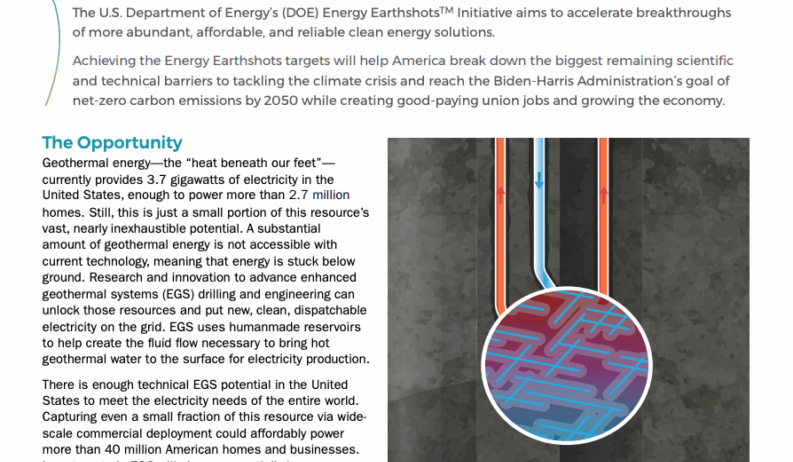Geothermal energy has emerged as a viable regenerative resource, harnessing Earth’s intrinsic heat for various applications, including electricity generation and direct heating solutions. However, the utilization of this natural power demands judicious conservation techniques to ensure sustainability and ecological balance. This discourse elucidates the principles of conserving geothermal energy while delving into its broader implications.
The fascination with geothermal energy stems from its unparalleled potential as a renewable resource. Unlike solar or wind energy, geothermal energy is available around the clock, unaffected by weather fluctuations or seasonal changes. Earth’s core retains an inexhaustible source of heat, primarily generated from the planet’s formation and radioactive decay of minerals. Consequently, the ability to efficiently harvest this energy is essential for addressing both energy security and climate change mitigation.
To commence the pathways to conserve geothermal energy, one must first understand the various mechanisms through which geothermal power can be harnessed. The primary methods encompass enhanced geothermal systems (EGS), geothermal power plants, and direct-use applications. Each mechanism operates in diverse thermal reservoirs, from shallow ground to deep geologic formations, necessitating a thorough comprehension of geothermal reservoirs’ thermal dynamics.
EGS represents a transformative technique that augments existing geothermal reservoirs. By injecting water into geothermal formations, it increases the reservoir’s capacity, thus elevating energy output. However, the extensive water usage in EGS necessitates a conscientious approach to water resource management, especially in arid regions. Incorporating a cyclic water use system, wherein water is continuously recirculated rather than newly sourced from external bodies, can significantly enhance conservation efforts.
Equally essential is the implementation of advanced geothermal power plants, which convert thermal energy into electricity. The efficiency of these plants can be bolstered through innovative technologies such as binary cycle systems, which utilize secondary working fluids with lower boiling points. This not only conserves geothermal resources but also minimizes environmental impacts, including land disruption and emissions. The transition to binary cycle systems exemplifies how technological advancements can underpin sustainable energy practices.
Direct-use applications present another avenue for conserving geothermal energy. These systems utilize geothermal heat directly, such as in district heating, greenhouse farming, and aquaculture operations. By strategically integrating geothermal heating in residential and commercial infrastructures, energy consumption can be significantly reduced. It is incumbent upon policymakers and industry stakeholders to prioritize the development of infrastructure that facilitates such direct-use applications, thus promoting wider acceptance and implementation.
Furthermore, engaging the local communities plays a pivotal role in geothermal conservation strategies. Communities are often the first to experience the implications of geothermal projects. Hence, fostering inclusive dialogues and participatory approaches can ensure that local knowledge and environmental aspirations are recognized and respected. Educational initiatives that elucidate the benefits and workings of geothermal energy can mitigate resistance and encourage public buy-in. To achieve optimal conservation levels, awareness campaigns should focus on the science behind geothermal energy, emphasizing its low environmental footprint compared to fossil fuels.
Additionally, rigorous regulatory frameworks are crucial in safeguarding geothermal resources. Governments must implement stringent policies that govern exploration, development, and resource management, thereby preventing overexploitation. A comprehensive approach should combine legislation that mandates environmental assessments with incentives for sustainable practices. For instance, tax breaks and grants for companies that invest in conservation technologies can catalyze broader industry change toward sustainable geothermal practices.
Implementing robust monitoring systems is also crucial in geothermal conservation efforts. By employing sophisticated data analytics and remote sensing technologies, operators can track and assess geothermal resources’ health over time. Continuous monitoring enables proactive management strategies that can identify issues before they escalate, ensuring that geothermal energy utilization remains within sustainable limits. This data-driven approach synthesizes the nexus between technology and resource management, establishing a comprehensive framework for conservation.
In the broader context, conserving geothermal energy aligns with the pursuit of a sustainable future. The shift toward renewable energy sources, including geothermal, is paramount in combating climate change. By judiciously utilizing the planet’s geothermal resources, not only can we reduce greenhouse gas emissions, but we can also foster ecological resilience and energy independence.
Moreover, geothermal energy plays a critical role in transitioning economies towards sustainability. The global energy landscape is increasingly recognizing the significance of diversifying energy portfolios. Countries heavily reliant on fossil fuels must invest in geothermal energy to ensure energy transitions are not only feasible but also socially just. This necessitates an inclusive approach that prioritizes socioeconomic equity, ensuring that marginalized communities benefit equitably from geothermal advancements.
As we contemplate the future of energy consumption, the intrinsic lessons derived from the conservation of geothermal energy stand to illuminate pathways toward holistic sustainability. Recognizing the latent potential of geothermal resources will necessitate a concerted global effort to embrace innovative technologies, establish robust policies, and foster community engagement. Inherent in this ambitious journey is a shared commitment to safeguarding the environment while paradoxically harnessing the very energy that resides within Earth’s depths.
Ultimately, the task at hand is both a challenge and an opportunity—an opportunity to unlock Earth’s natural power wisely, conserving geothermal energy for generations to come. The gravitational pull of this resource presents a beacon of hope in our collective quest to forge a sustainable future.







